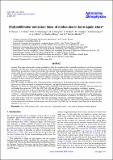Por favor, use este identificador para citar o enlazar a este item:
http://hdl.handle.net/10261/167600COMPARTIR / EXPORTAR:
 SHARE SHARE
 CORE
BASE CORE
BASE
|
|
| Visualizar otros formatos: MARC | Dublin Core | RDF | ORE | MODS | METS | DIDL | DATACITE | |

| Título: | (Sub)millimeter emission lines of molecules in born-Again stars? |
Autor: | Tafoya, D.; Toalá, J. A.; Vlemmings, W. H. T.; Guerrero, Martín A. CSIC ORCID; Beck, E. D.; González, M.; Kimeswenger, S.; Zijlstra, A. A.; Sánchez-Monge, Á.; Treviño-Morales, S. P. | Palabras clave: | Circumstellar matter Stars: mass-loss Planetary nebulae: general Stars: AGB & post-AGB Stars: carbon |
Fecha de publicación: | 2017 | Editor: | EDP Sciences | Citación: | Astronomy and Astrophysics 600: A23 (2017) | Resumen: | Context. Born-Again stars provide a unique possibility to study the evolution of the circumstellar envelope of evolved stars in human timescales. Up until now, most of the observations of the circumstellar material in these stars have been limited to studying the relatively hot gas and dust. In other evolved stars, the emission from rotational transitions of molecules, such as CO, is commonly used to study the cool component of their circumstellar envelopes. Thus, the detection and study of molecular gas in born-Again stars is of great importance when attempting to understand their composition and chemical evolution. In addition, the molecular emission is an invaluable tool for exploring the physical conditions, kinematics, and formation of asymmetric structures in the circumstellar envelopes of these evolved stars. However, up until now, all attempts to detect molecular emission from the cool material around born-Again stars have failed. Aims. We searched for emission from rotational transitions of molecules in the hydrogen-deficient circumstellar envelopes of bornagain stars to explore the chemical composition, kinematics, and physical parameters of the relatively cool gas. Methods. We carried out observations using the APEX and IRAM 30 m telescopes to search for molecular emission toward four well-studied born-Again stars, V4334 Sgr, V605 Aql, A30, and A78, that are thought to represent an evolutionary sequence. Results. For the first time, we detected emission from HCN and HCN molecules toward V4334 Sgr, and CO emission in V605 Aql. No molecular emission was detected above the noise level toward A30 and A78. The detected lines exhibit broad linewidths 150 km s, which indicates that the emission comes from gas ejected during the born-Again event, rather than from the old planetary nebula. A first estimate of the HCN/HCN abundance ratio in the circumstellar environment of V4334 Sgr is ≈ 3, which is similar to the value of the 12C/13C ratio measured from other observations. We derived a rotational temperature of Trot = 13 ± 1 K, and a total column density of NHCN = 1:6 ± 0:1 × 10 cm for V4334 Sgr. This result sets a lower limit on the amount of hydrogen that was ejected into the wind during the born-Again event of this source. For V605 Aql, we obtained a lower limit for the integrated line intensities I12CO/I13CO > 4.©ESO 2017. | URI: | http://hdl.handle.net/10261/167600 | DOI: | 10.1051/0004-6361/201630074 | Identificadores: | doi: 10.1051/0004-6361/201630074 issn: 1432-0746 |
| Aparece en las colecciones: | (IAA) Artículos (ICMM) Artículos |
Ficheros en este ítem:
| Fichero | Descripción | Tamaño | Formato | |
|---|---|---|---|---|
| IAA_2017_aa30074-16.pdf | 522,41 kB | Adobe PDF |  Visualizar/Abrir |
CORE Recommender
SCOPUSTM
Citations
8
checked on 15-abr-2024
WEB OF SCIENCETM
Citations
8
checked on 25-feb-2024
Page view(s)
310
checked on 18-abr-2024
Download(s)
158
checked on 18-abr-2024
Google ScholarTM
Check
Altmetric
Altmetric
NOTA: Los ítems de Digital.CSIC están protegidos por copyright, con todos los derechos reservados, a menos que se indique lo contrario.
